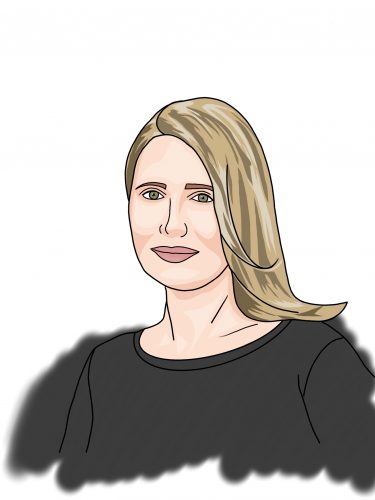Art by Anmei Little.
For someone like Erika Check Hayden, a career in science journalism was the perfect match. The daughter of two scientists, her early passion for science bloomed as she immersed herself in different labs, internships, and educational experiences. However, her calling to science journalism was not clear until her undergraduate career as a biology major at Stanford University.
As a writer for The Stanford Daily, Check Hayden fell in love with gathering information and presenting it in a digestible, compelling, and accurate narrative. Combining her newfound interest in reporting with her curiosity for science, she set her focus on science journalism. This path offered her the possibility to engage with multiple scientific fields, such as genetics, infectious diseases, and biomedical innovations—without having to focus on just one.
After graduating, Check Hayden served as a reporter for Nature for 15 years, during which she wrote her award-winning coverage of the 2014 Ebola epidemic in Sierra Leone. Initially, Check Hayden covered the story from San Francisco, before choosing to report from the heart of the outbreak in Africa. There, she quickly discovered that the reality of Ebola was far different from its portrayal in American media. She recognized how these American stories were centered in Western involvement, often failing to highlight the tremendous efforts of African healthcare workers and scientists. On one occasion, Check Hayden recalled meeting three courageous women working tirelessly as nurses at an Ebola clinic, despite having survived the disease themselves. The Western misconception that the African response was incompetent catalyzed Check Hayden’s mission to depict frontline workers in an honest, undistorted light.
As COVID-19 has disrupted our world, reliable scientific communication has proven to be of paramount importance. “You can see clearly that the spread of misinformation is hampering the response to this disease, and it’s why the U.S. is leading the developed world in terms of cases,” Check Hayden said. In response to such issues, her Science Communication Master’s Program at the University of California Santa Cruz (UCSC) deliberately works on combating the spread of misinformation by training students to develop the skills to tell engaging, authentic stories. This is the lifeblood of science journalism—to be accurate and factual is necessary, and to be engaging is to attract and keep the attention of readers.
First introduced as a program lecturer, Check Hayden quickly realized how unique the program was. “[The program] specializes in taking people who have science backgrounds and giving them the tools to make an impact through journalism and communication careers,” she explained. The curriculum is designed for students to partake in part-time internships alongside their coursework, receive training in social media, and develop close relationships with mentors and professional media outlets.
Seeking to amplify the voices of writers that have too long been ignored and excluded, Check Hayden embraced her new role as the program’s director in 2017. “It became more important for me to try to use my position to help make coverage in science journalism more inclusive, to empower young journalists to tell the stories that they think need to be told about science and society,” she said. In addition to practical training, the program also prepares its students, the majority of whom identify as women and non-binary people, to take on leadership positions in a field still largely dominated by men. According to The Status of Women in the U.S. Media 2019 report produced by the Women’s Media Center, women received just thirty-seven percent of byline and other credits in television, online, print, and wire news in 2017.
Reflecting on her own experience as a young reporter in a field with a prevalent “boys’ club atmosphere,” Check Hayden understood the importance of representation and mentorship. She drew support from inspiring women editors at Nature like Helen Pearson, Alexandra Witze, and Lauren Morello, who advocated for her work and helped her navigate the field. She also cites her parents as a major source of support. “Instead of trying to push me towards a more conventional or practical career, they actively supported me in continuing with my writing and finding a way to use it,” she said.
When thinking of the future of science journalism, she is energized by skilled young journalists ethically addressing modern issues like COVID-19 and telling stories inclusively, which helps readers better connect with science. “If we can expand our thinking about what makes for good stories, how to tell these stories, and who deserves being covered, then we’re going to make a bigger impact with our journalism.”
CITATIONS:
Women’s Media Center. (2019). The Status of Women in the U.S. Media 2019 (Rep.) Retrieved September 29, 2020, from https://tools.womensmediacenter.com/page/-/WMCStatusofWomeninUSMedia2019.pdf

